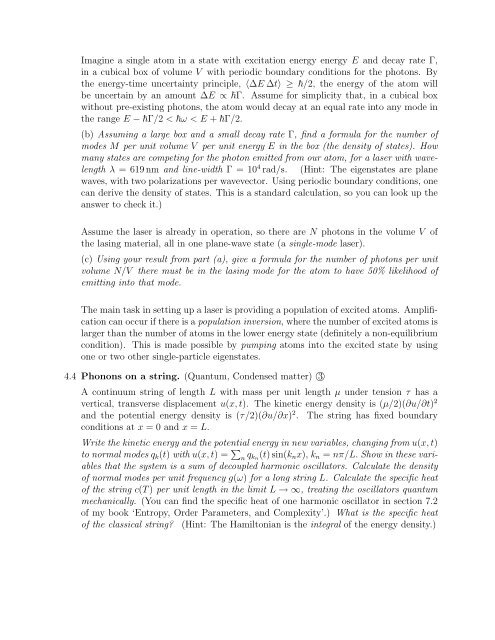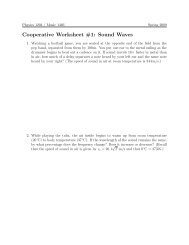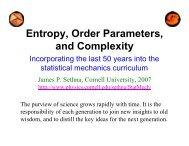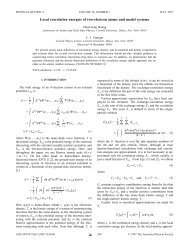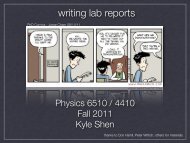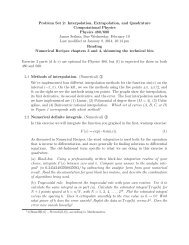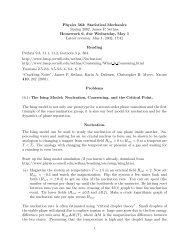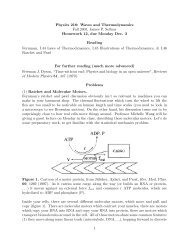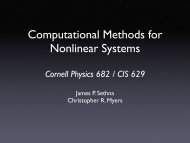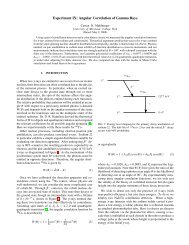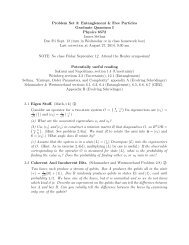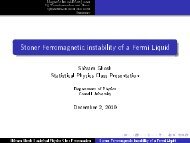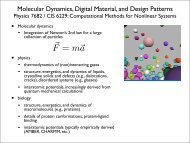4. Bosons, Fermions, and Anyons - Are you sure you want to look at ...
4. Bosons, Fermions, and Anyons - Are you sure you want to look at ...
4. Bosons, Fermions, and Anyons - Are you sure you want to look at ...
Create successful ePaper yourself
Turn your PDF publications into a flip-book with our unique Google optimized e-Paper software.
Imagine a single a<strong>to</strong>m in a st<strong>at</strong>e with excit<strong>at</strong>ion energy energy E <strong>and</strong> decay r<strong>at</strong>e Γ,in a cubical box of volume V with periodic boundary conditions for the pho<strong>to</strong>ns. Bythe energy-time uncertainty principle, 〈∆E ∆t〉 ≥ /2, the energy of the a<strong>to</strong>m willbe uncertain by an amount ∆E ∝ Γ. Assume for simplicity th<strong>at</strong>, in a cubical boxwithout pre-existing pho<strong>to</strong>ns, the a<strong>to</strong>m would decay <strong>at</strong> an equal r<strong>at</strong>e in<strong>to</strong> any mode inthe range E − Γ/2 < ω < E + Γ/2.(b) Assuming a large box <strong>and</strong> a small decay r<strong>at</strong>e Γ, find a formula for the number ofmodes M per unit volume V per unit energy E in the box (the density of st<strong>at</strong>es). Howmany st<strong>at</strong>es are competing for the pho<strong>to</strong>n emitted from our a<strong>to</strong>m, for a laser with wavelengthλ = 619 nm <strong>and</strong> line-width Γ = 10 4 rad/s. (Hint: The eigenst<strong>at</strong>es are planewaves, with two polariz<strong>at</strong>ions per wavevec<strong>to</strong>r. Using periodic boundary conditions, onecan derive the density of st<strong>at</strong>es. This is a st<strong>and</strong>ard calcul<strong>at</strong>ion, so <strong>you</strong> can <strong>look</strong> up theanswer <strong>to</strong> check it.)Assume the laser is already in oper<strong>at</strong>ion, so there are N pho<strong>to</strong>ns in the volume V ofthe lasing m<strong>at</strong>erial, all in one plane-wave st<strong>at</strong>e (a single-mode laser).(c) Using <strong>you</strong>r result from part (a), give a formula for the number of pho<strong>to</strong>ns per unitvolume N/V there must be in the lasing mode for the a<strong>to</strong>m <strong>to</strong> have 50% likelihood ofemitting in<strong>to</strong> th<strong>at</strong> mode.The main task in setting up a laser is providing a popul<strong>at</strong>ion of excited a<strong>to</strong>ms. Amplific<strong>at</strong>ioncan occur if there is a popul<strong>at</strong>ion inversion, where the number of excited a<strong>to</strong>ms islarger than the number of a<strong>to</strong>ms in the lower energy st<strong>at</strong>e (definitely a non-equilibriumcondition). This is made possible by pumping a<strong>to</strong>ms in<strong>to</strong> the excited st<strong>at</strong>e by usingone or two other single-particle eigenst<strong>at</strong>es.<strong>4.</strong>4 Phonons on a string. (Quantum, Condensed m<strong>at</strong>ter) ○3A continuum string of length L with mass per unit length µ under tension τ has avertical, transverse displacement u(x, t). The kinetic energy density is (µ/2)(∂u/∂t) 2<strong>and</strong> the potential energy density is (τ/2)(∂u/∂x) 2 . The string has fixed boundaryconditions <strong>at</strong> x = 0 <strong>and</strong> x = L.Write the kinetic energy <strong>and</strong> the potential energy in new variables, changing from u(x, t)<strong>to</strong> normal modes q k (t) with u(x, t) = ∑ n q k n(t) sin(k n x), k n = nπ/L. Show in these variablesth<strong>at</strong> the system is a sum of decoupled harmonic oscilla<strong>to</strong>rs. Calcul<strong>at</strong>e the densityof normal modes per unit frequency g(ω) for a long string L. Calcul<strong>at</strong>e the specific hea<strong>to</strong>f the string c(T ) per unit length in the limit L → ∞, tre<strong>at</strong>ing the oscilla<strong>to</strong>rs quantummechanically. (You can find the specific he<strong>at</strong> of one harmonic oscilla<strong>to</strong>r in section 7.2of my book ‘Entropy, Order Parameters, <strong>and</strong> Complexity’.) Wh<strong>at</strong> is the specific hea<strong>to</strong>f the classical string? (Hint: The Hamil<strong>to</strong>nian is the integral of the energy density.)


